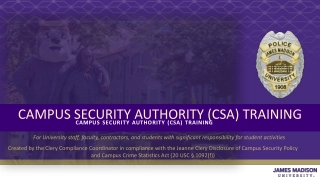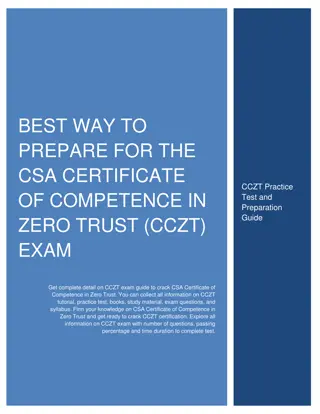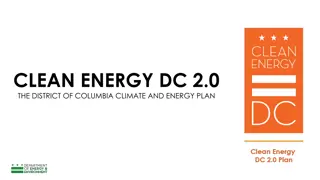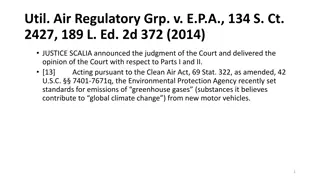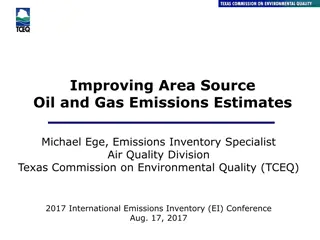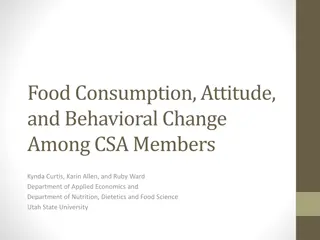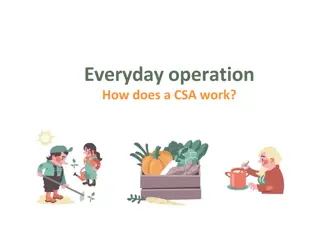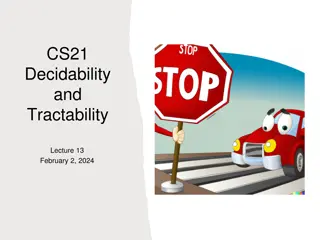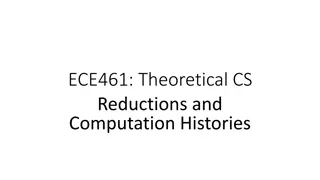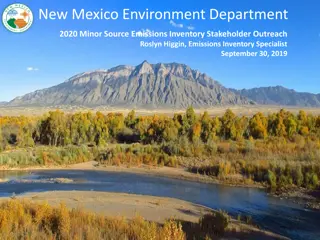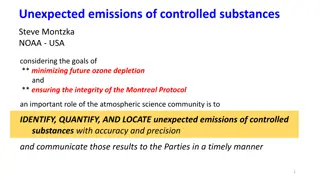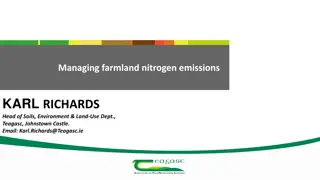Emissions Reductions Beyond the Clean Smokestacks Act (CSA) Overview
Emissions Reductions Beyond the Clean Smokestacks Act (CSA) is a comprehensive program aimed at improving air quality by imposing limits on pollutant emissions from coal-burning facilities. The act has successfully achieved significant reductions in nitrogen oxide (NOx) and sulfur dioxide (SO2) emissions, leading to improved environmental compliance and cost recovery provisions for pollution control measures. The program has had a positive impact on air pollution control and has supported compliance with various federal rules, ultimately benefiting public health and the environment.
Download Presentation

Please find below an Image/Link to download the presentation.
The content on the website is provided AS IS for your information and personal use only. It may not be sold, licensed, or shared on other websites without obtaining consent from the author. Download presentation by click this link. If you encounter any issues during the download, it is possible that the publisher has removed the file from their server.
E N D
Presentation Transcript
Emissions Reductions Beyond the Clean Smokestacks Act (CSA) Environmental Management Commission & Air Quality Committee November 2013 Sushma Masemore, PE Planning Section Chief Division of Air Quality Department of Environment and Natural Resources
CSA Background Session Law 2002-4 AN ACT TO IMPROVE AIR QUALITY IN THE STATE BY IMPOSING LIMITS ON THE EMISSION OF CERTAIN POLLUTANTS FROM CERTAIN FACILITIES THAT BURN COAL TO GENERATE ELECTRICITY AND TO PROVIDE FOR RECOVERY BY ELECTRIC UTILITIES OF THE COSTS OF ACHIEVING COMPLIANCE WITH THOSE LIMITS. http://www.ncleg.net/Sessions/2001/Bills/Senate/HTML/S1078v5.html An early action state program to control air pollution from coal-fired power plants. Set entity-wide emission limits for nitrogen oxide (NOx) and sulfur dioxide (SO2). NOx is the main cause of ozone formation. SO2is the main cause of fine particulate pollution, haze, and acid rain. 2
CSA Background Emission Limits NOx: 245,000 tons in 1998 SO2: 489,000 tons in 1998 Emission cuts achieved through actual reductions not by buying or trading credits from utilities in other states. Cost recovery provision for installing new pollution controls. 60,000 tons by 2007 (76% reduction) 56,000 tons by 2009 (78% reduction) 250,000 tons by 2009 (49% reduction) 130,000 tons by 2013 (74% reduction) 3
Affected Plants & Operating Status Jan. 2014 4
2013 Annual CSA Report Jointly prepared by DENR and NC Utilities Commission All permitting, construction, and equipment testing completed Net environmental compliance cost = $2.89 billion 2014 Predicted = 28,832 tons -Duke Power 2014 Predicted = 21,884 tons -Duke Power 5
CSA one of contributing programs to help achieve declining Ozone levels 6
Other Impacts Attainment of fine particulate matter (PM2.5) National Ambient Air Quality Standard (NAAQS) CSA related SO2 reductions supported redesignation demonstration for the Hickory and Greensboro, Winston-Salem, & High Point areas EPA adopted CSA emission caps into N.C. State Implementation Plan Regional Haze 5-Year Progress Report concluded that N.C. s national parks and wilderness areas are on track to meet visibility goals NC Utilities well positioned to comply with federal rules: Clean Air Interstate Rule (CAIR), Cross State Air Pollution Rule (CSAPR), Mercury & Air Toxics Rule (MATS) Compliance costs for Duke Energy and Progress Energy spread out over 11 years Other utilities will have 3-5 years to comply 7
Recent Studies Benefits of Early State Action in Environmental Regulation of Electric Utilities: North Carolina s Clean Smokestacks Act, July 2012 David Hoppock, Sarah K. Adair, Brian Murray, and Jeremy Tarr, Duke University Nicholas Institute for Environmental Policy Solutions http://nicholasinstitute.duke.edu/sites/default/files/publications/ni_wp_12-05.pdf Dynamic of air quality and respiratory mortality in North Carolina in 1992-2010 J. Kravchenko, I. Akushevich, A.P. Abernethy, S. Holman, W.G. Ross, Jr, and H. K. Lyerly Currently under peer review with PLoS ONE 8
Beyond CSA Study Section 11 EMC to report the need for further NOx and SO2 reductions Biennially starting Sept. 1, 2011 Sept. 1 2011 Report Findings Many pending actions at local, regional and national levels could influence the EMC s recommendations CSA units still adding controls, being retired, or converted to natural gas TVA settlement with N.C. still being implemented Pending litigation with EPA s interstate transport rules (CAIR and CSAPR) MATS for new and existing coal and oil fired plants still being implemented Recommended further state actions to be presented on Sept. 1, 2013 9
Beyond CSA Sept. 1, 2013 Report Key federal judicial decisions and rulemaking actions remain undetermined CSAPR: Supreme Court to hear oral arguments on Dec.10, 2013 CAIR: temporarily reinstated pending CSAPR outcome MATS: implementation on-going Revised Ozone NAAQS: delayed until 2015 New1-hour SO2 NAAQS: Implementation rule expected in late 2013; threshold based requirements will affect larger coal-fired electric generating units (EGUs) Carbon Pollution Standards: EPA rules affecting new and existing power plants expected in 2014/2015 10
Beyond CSA 2013 Report EMC Recommendations NC EGUs Significant reductions in NOx and SO2 already achieved; On course to meet CAIR and MATS rules EGUs in Neighboring States significant emission reductions expected due to installation of new pollution controls and closing of smaller plants to comply with MATS rule by March 2015 Impact of these reductions on future ozone NAAQS will depend on the level of the final standard set by EPA in 2015. Biannual report is no longer necessary. Upon issuance of a new NAAQS, DENR will evaluate the need for reductions beyond CSA to attain and maintain the NAAQS. If additional controls are necessary, DENR will initiate necessary rules changes, or open air permits to include new emission limitation, or both. 11
Questions? 12






